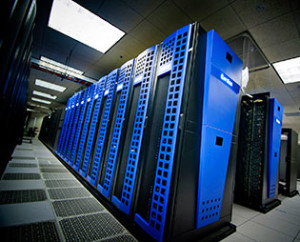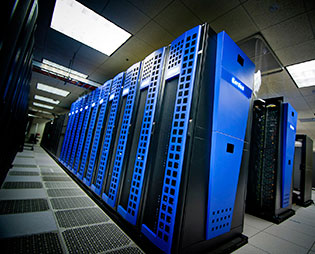 The National Science Foundation has awarded the San Diego Supercomputer Center (SDSC) a one-year extension to continue operating its Gordon supercomputer, providing continued access to the cluster for a wide range of researchers with data-intensive projects.
The National Science Foundation has awarded the San Diego Supercomputer Center (SDSC) a one-year extension to continue operating its Gordon supercomputer, providing continued access to the cluster for a wide range of researchers with data-intensive projects.
We are delighted that Gordon will be available to researchers for another year, especially to those who are working in data-intensive domains such as social and political science, earth sciences, molecular biology and chemistry, genomics, and experimental high energy physics,” said SDSC Director Michael Norman, who also is the principal investigator for the Gordon supercomputer project. “Gordon has served the research community very well, and the NSF’s decision provides scientists continued access to what remains a state-of-the-art system.”
The result of a five-year, $20 million NSF grant awarded in late 2009, Gordon entered operations in early 2012 as one of the 50 fastest supercomputers in the world at the time – and the only one to employ massive amounts of flash-based memory, making it many times faster than conventional high-performance computing (HPC) systems for some data-intensive analyses.
With 300 trillion bytes of flash memory and 64 I/O nodes, Gordon is ideal for researchers who need to sift through tremendous amounts of data. In effect, Gordon was designed to do for scientific research what Google does for web searches. Learn more about Gordon’s full specifications on the SDSC HPC Systems webpage. By the end of 2014, 1,098 research projects using Gordon were awarded among 762 principal investigators at numerous academic institutions across the U.S. including UC San Diego and the UC system.
The one-year extension, until August 31, 2016, is being made possible through a combination of unspent funds and additional funding from the NSF. The extension will benefit researchers, the majority of whom access the system through the NSF’s XSEDE (eXtreme Science and Engineering Discovery Environment) program, which comprises the most advanced collection of integrated digital resources and services in the world.
Extending Gordon provides a number of important benefits to XSEDE and its research community,” said Bob Sinkovits, director of the Scientific Applications Group in SDSC’s Data-Enabled Scientific Computing Division. “Gordon is a primary resource for several widely used Science Gateways that serve large communities of users. These include CIPRES, for phylogenetic inference; GridChem for computational chemistry; and UltraScan, for analysis of ultracentrifuge data. Gordon also hosts a number of novel projects ranging from the biomedical sciences to analysis of the Internet, which require persistent access to flash storage and are not currently handled by other XSEDE resources.”




